Highland cattle are a domestic breed of cattle primarily raised for meat production, but they are also recognized as a rustic breed.
This rustic quality comes from their great toughness and ability to live well in difficult weather.
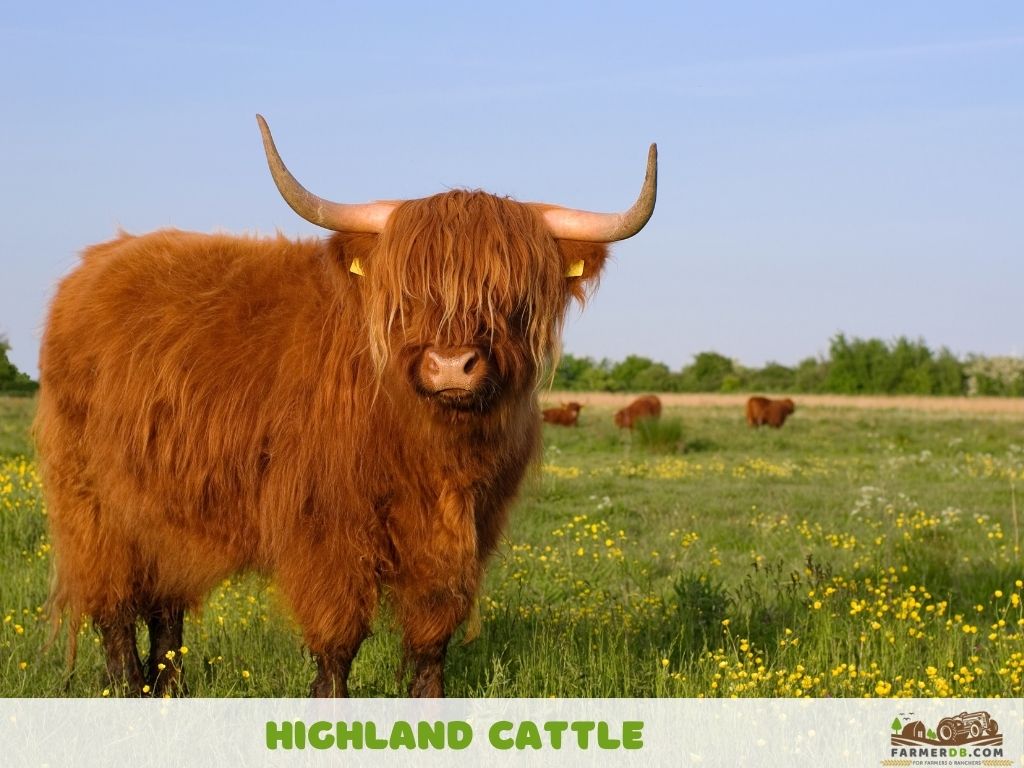
They are often called Scottish Highland cattle or simply Highlanders.
Their ancestors came from Scotland, and people have raised this breed for over 1,000 years. They are named after the Scottish Highlands, where they have lived for many years.
Characteristics
Physical Characteristics
They have physical traits that make them highly recognizable, not only to those who work with livestock but also to people with minimal knowledge about cattle.
Colors
While the classic image is of red-haired cattle, their coats come in various colors, including black, brindle, dun, yellow, white, and silver.
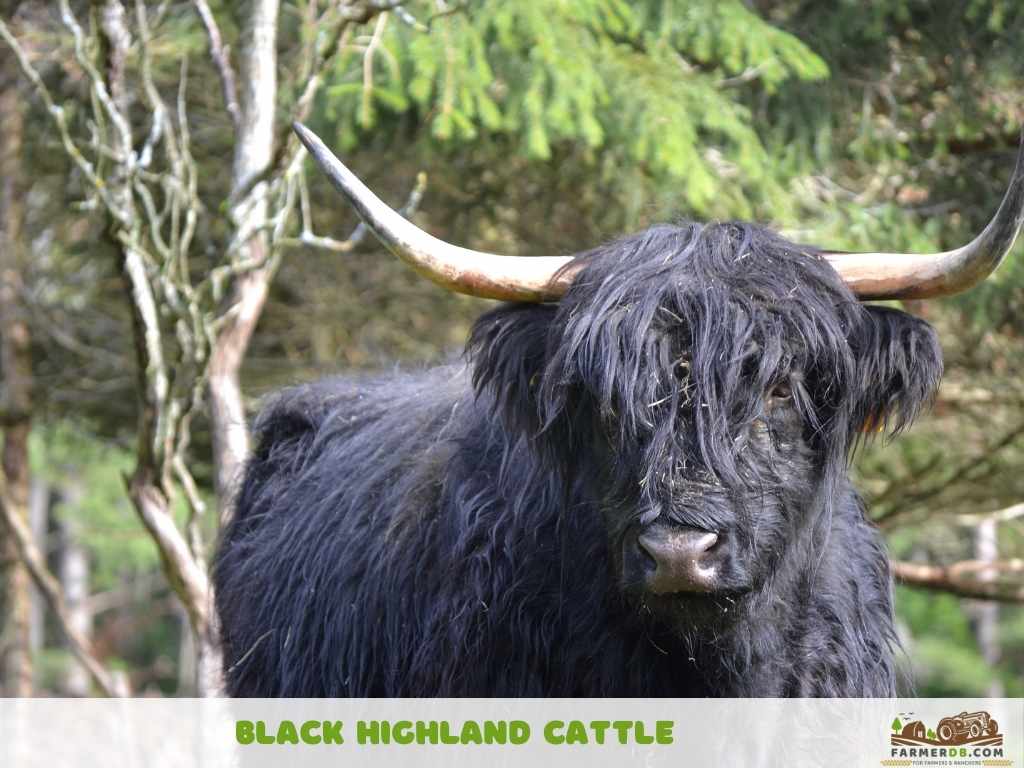
Hair
They have a double layer of hair.
The outer coat is long and wavy, acting as a shield. Beneath this, there is a shorter, straight undercoat that provides insulation and keeps the animal warm.
The outer coat should not be overly curly, as this is seen as a fault.
Head, Face, Eyes
The head is one of the most striking features, with a grand and proportionate shape that complements the body.
It is broad between the eyes and short from the eyes to the muzzle. A wide, long, and bushy forelock enhances its attractive appearance.
Some prefer the forelock to be so thick and wide that it almost covers the eyes.
The eyes are bold, bright, and alert, displaying courage when the animal is excited. The jawbones are proportionate to the head’s width, and the short, broad muzzle with fully open nostrils reflects good breeding.
Horns
Highland cattle are naturally horned.
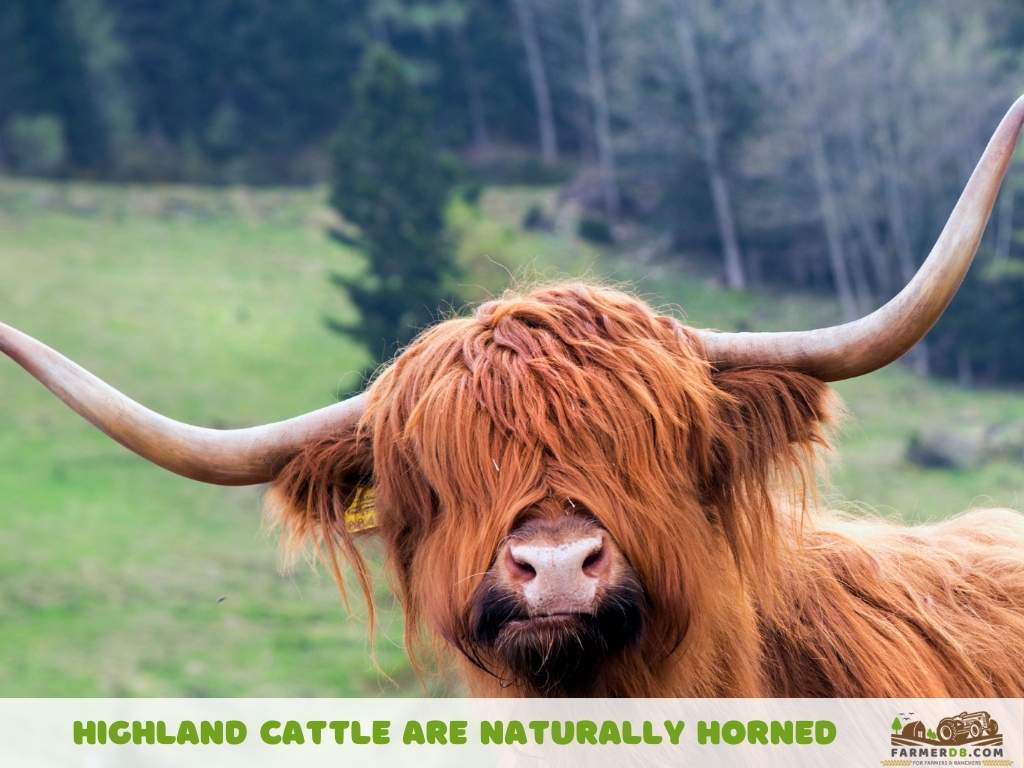
In males, the horns are strong and grow straight out from the head, slightly inclining forward and curving upward toward the tips.
In females, the horns are squarer where they emerge from the head, rising sooner and growing somewhat longer. Female horns often have a backset curve and a wide sweep, which gives them an elegant appearance.
Some horns in females maintain a reddish color at the tips, adding to their distinctive look.
Shoulders
The shoulders are strong and well-built, connecting smoothly from the neck to the forearm.
Bulls have a crest on their neck, which gives them a strong and masculine look. The shoulders fit naturally into the body, giving it a solid and powerful appearance.
Front Legs
The front legs are short, strong, and set wide apart. They have broad, straight bones and a good covering of hair. The hoofs are well-formed and large, providing stability and ease of movement.
Back
The back is fully developed, rounded, and straight, with no hollows or dips. The ribs are well-rounded, deep, and provide a broad, strong structure. The hips are wide, and the quarters are square and balanced, giving a solid and symmetrical appearance.
Back Legs
The back legs are equally strong and slightly angled when viewed from the side. They align perfectly with the body, ensuring efficient movement.
The hoofs are well-placed and provide excellent traction, with the hind feet stepping into the tracks of the front feet during movement.
Udder
The udder is level and well-formed, with four evenly spaced teats of similar size. The rear suspensory ligament extends high, ensuring proper support and structure.
Teats
The teats are evenly sized and positioned, making them efficient for feeding calves.
Size
They are a medium-sized breed of cattle.
Bulls can reach a height of 49 inches (125 cm) at the shoulder when fully grown. Cows of this breed are smaller, averaging a height of 41 inches (105 cm) at the shoulder at maturity.
In terms of body length, they usually measure about 5.5 to 6.5 feet (170–200 cm) from the nose to the base of the tail.
Lifespan
Their lifespan is usually around 15 to 20 years, but some can live even longer if they are well cared for.
This type of cattle has a longer lifespan compared with other breeds, such as the Belgian Blue.
Growth Rate
How fast do they grow?
They have a slow growth rate.
It usually takes around 2 to 3 years for the breed to reach a good market weight.
When it comes to calves, they do grow faster during their early months. At birth, the calves typically weigh between 50 to 75 lbs (22 to 34 kg), which is similar to many other cattle breeds.
One of the reasons calves of this breed can grow faster in the early stages is the milk from their mothers.
The milk produced by this breed has a higher fat content than that of many other cattle breeds. This rich milk provides more energy and nutrients, which helps the calves grow more quickly during their first few months of life.
However, after this early growth spurt, their growth slows down as they mature.
Weight
When fully mature, the males reach a maximum weight of 1,500 to 2,000 lbs (680 to 910 kg), while females weigh between 900 to 1,200 lbs (410 to 545 kg).
These weights can depend on factors like diet, care, and environmental conditions, but these are the general ranges for each sex.
Slaughtered Time
These cattle can be slaughtered around 25 to 36 months of age, or once they reach a weight of about 990 to 1,100 lbs (450 to 500 kg).
While this isn’t a precise science, they are usually sent to slaughter when they have reached the desired body condition.
Once processed, you can expect to yield about 55% to 65% of the live weight as carcass weight.
For example, a 1,200-pound (540 kg) Highland cow may yield approximately 660 to 780 lbs (300 to 350 kg) of carcass weight.
After further processing into retail cuts, the actual saleable meat might account for around 40% to 50% of the carcass weight, resulting in about 260 to 390 lbs (120 to 175 kg) of meat ready for sale.
Temperament and Behaviour
This breed is gentle and calm.
They are not aggressive and typically get along well with both humans and other animals.
These cattle also have some unique traits. One of these is their curiosity, especially when something new appears in their environment.
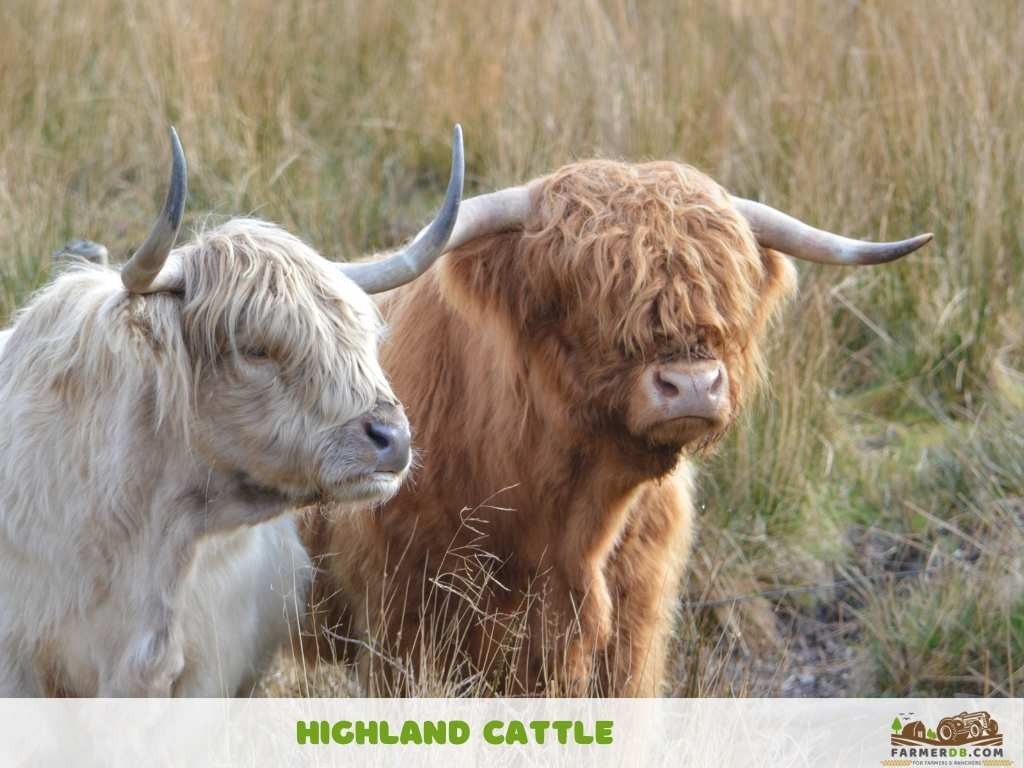
Additionally, they are very social and prefer being in the company of others. It’s common to see them staying close to their herd mates, as they feel more secure and relaxed in a group setting.
These cattle are natural grazers, so this behavior is also specific to their breed.
The bulls can be aggressive during the mating season.
Meat
The meat from this breed of cattle is very lean and low in fat, which makes it a healthier choice compared to other types of beef.
It has so little fat that it’s almost on par with chicken and fish in terms of fat content.
Even though the meat is lean, it still has enough marbling, which gives it a tender and juicy texture.
You can expect it to be succulent and full of flavor, similar to beef from larger breeds, but with less fat. The texture is firm and smooth, making it perfect for different ways of cooking, whether you’re grilling, roasting, or slow-cooking.
If you take a close look at the color, you’ll notice that the meat has a rich red hue, which is common for naturally raised beef.
What stands out, though, is the flavor. It’s full-bodied, with a taste that people describe as traditional and old-fashioned, which comes from the cattle’s natural diet and slower growth process.
This meat is a good source of protein and iron and contains more protein than regular beef.
It’s also rich in:
- Omega-3 fatty acids
- Conjugated linoleic acid (CLA)
- Vitamin A, E, B
- Zinc, selenium, phosphorus
| Nutrient | Highland Beef | Other Beef |
|---|---|---|
| Fat | 4.5 g | 15.6 g |
| Cholesterol | 40.9 mg | 64.3 mg |
| Protein | 20.7 g | 18.6 g |
| Iron | 2.1 mg | 2.0 mg |
| Omega-3 | Higher | Lower |
| CLA | Higher | Lower |
| Vitamins A & E | Higher | Lower |
| Vitamin B12 | Higher | Lower |
| Zinc | Higher | Lower |
| Selenium | Higher | Lower |
Highland cows are primarily raised for their meat, but you can also milk a female Highland cow. However, you won’t get as much milk as you would from a dairy cow. Their milk is rich in butterfat, protein, and calcium.
Raising
Raising these cattle is generally straightforward, as they are hardy animals that thrive in various environments.
Feeding
You can feed them grass and forage.
They are natural grazers, so they mainly eat grass and forage. You can allow them to graze in fields, where they will enjoy fresh grass during the warmer months.
In the colder months, when fresh grass isn’t available, you can feed them silage (fermented grass), hay, and straw to ensure they get enough nutrition.
For good health and shape, Highland cows also need minerals and vitamins.
You can provide them with mineral licks or supplements to help with their nutritional needs, especially in winter when natural grazing is limited.
They also enjoy eating herbs and shrubs when they have access to them, which adds variety to their diet.
You can also supplement their diet with root vegetables, like turnips or carrots, especially if you need to keep them healthy during the winter months when fresh grass is scarce.
Environment
Open systems like pastures and farms with access to large outdoor areas are often ideal for Highland cows.
They enjoy being outdoors and can graze freely, which is better for their natural behaviors.
In an open system, you can let them roam and enjoy a more natural lifestyle, which helps them stay healthy and in good condition.
Climate
The perfect climate for these cattle is a cold one, with chilly or even snowy weather.
Their thick coat keeps them warm in the winter, making them well-suited to colder areas.
But you can also raise them in milder or even warmer climates.
While they thrive in cooler temperatures, they can adjust to warmer weather as long as they have access to shade and fresh water.
In hotter climates, you will need to make sure they are not exposed to the sun too long, as they can get overheated.
Shelter
In general, they do not need a shelter as they are very hardy animals and can handle cold weather.
But you can provide them with one during extreme weather conditions, like very heavy snow or strong storms.
Having a shelter can help keep them safe and give them a place to rest out of the harsh winds and rain. It’s not necessary for daily life, but it can be important during severe weather to ensure they stay comfortable.
In terms of fencing, you don’t have to worry too much about them escaping, as they are naturally calm and not likely to wander off. But if you want to practice rotational grazing or keep them in a specific pasture, you should consider using an electric fence for cattle.
How many cattle per acre?
You can raise 1 Highland cattle per 3.5 to 4 acres.
In regions with poor-quality grass or limited rainfall, you could need even 6 to 8 acres per cow.
Breeding
Breeding them can be relatively easy, but there are a few things you need to know to make sure the process goes smoothly.
Females usually reach sexual maturity at around 18 to 24 months, and that’s when they can start breeding.
These cattle are a maternal breed.
You can breed them naturally, which is quite common. Many farmers prefer this method because it is simple and natural.
The best time to breed a cow is when she is in heat, which usually lasts about 18 to 24 hours.
You can tell when a cow is in heat because she will be more restless, and you may notice that she stands still and allows the bull to mount.
The gestation period for a Highland cow is around 280 days (about 9 months), just like most other cattle breeds.
When it comes to giving birth, most Highland cows have easy births and rarely need assistance. They are usually good mothers and will take care of their calves without much help.
These cattle usually have one calf per year. They are excellent mothers, caring for their calves and ensuring they receive enough milk.
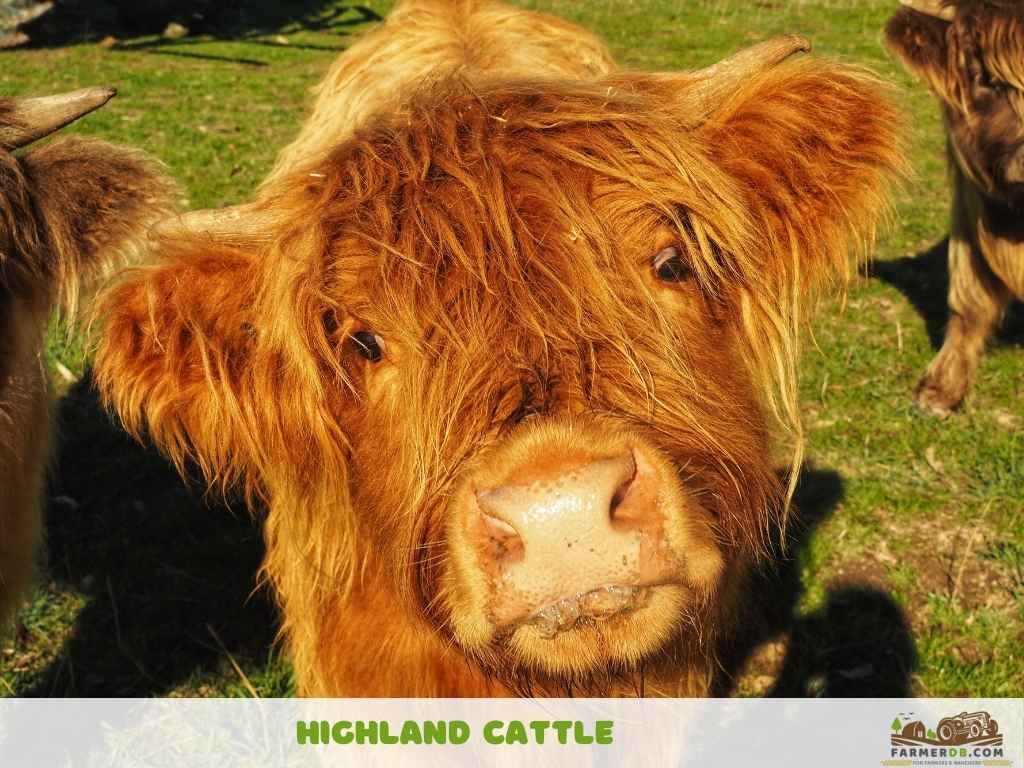
The milk supply is sufficient, especially for the first few months, though it may not be as large as milk from dairy breeds.
In terms of breeding, a cow can typically be bred from around 2 years old until she is about 12 to 14 years old, depending on her health and condition.
After this age, she may not be as productive, and many farmers choose to retire her from breeding.
Health Issues
These are hardy animals.
There are no specific diseases that affect Highland cattle more than other breeds, but they are still susceptible to common cattle diseases that you should be aware of.
Some of the common cattle diseases include brucellosis, bovine tuberculosis, and foot and mouth disease.
Another thing to keep in mind is that Highland cattle, due to their thick coats, can sometimes struggle with heat stress during hot summer months.
They are also at risk for parasites like lice, ticks, and worms, just like other cattle. Regular deworming and keeping the pasture clean can help prevent these problems.
Why should you raise it?
This cattle breed is a great fit for homesteaders who want hardy, low-maintenance animals for meat production in smaller-scale farming.
The price of a Highland cow can depend on its age and gender.
Calves usually cost less than adult cows, with prices typically between $500 and $1,500.
Mature cows, particularly those that are ready for breeding, can range from $1,500 to $3,500.
Bulls, because of their ability to breed, can be priced between $2,000 and $4,000.
First, they are hardy animals that can thrive in cold climates, which makes them perfect for small farms in colder areas. They are also low-maintenance, meaning they don’t require a lot of extra care compared to other breeds.
Their natural grazing habits also make them good foragers, so they can feed on a variety of grasses and forages, reducing the need for constant feed.
These cattle are not suitable for larger-scale businesses due to their slow growth rate.
Advantages and Disadvantages
Advantages
- Hardy and resilient, able to thrive in cold climates.
- Good foragers and can graze on a variety of grasses and forages.
- Low maintenance and require minimal intervention for breeding and care.
- Produce high-quality meat with a rich flavor.
- Calm and friendly temperament, making them easier to handle.
Disadvantages
- Can struggle with heat stress in warmer climates due to thick coats.
- Slow growth rate compared to other breeds.
- Smaller milk production compared to dairy breeds.
- Can be harder to find in large numbers for commercial farming.
- Require supplemental feeding during the winter months due to slower pasture growth.
Contents
Do you have any experience with the topic discussed here?
Would you like to improve the information shared and contribute your practical knowledge on the subject?
Your real-world experience as a farmer or rancher could greatly benefit other members, and the community would deeply appreciate your contribution.


